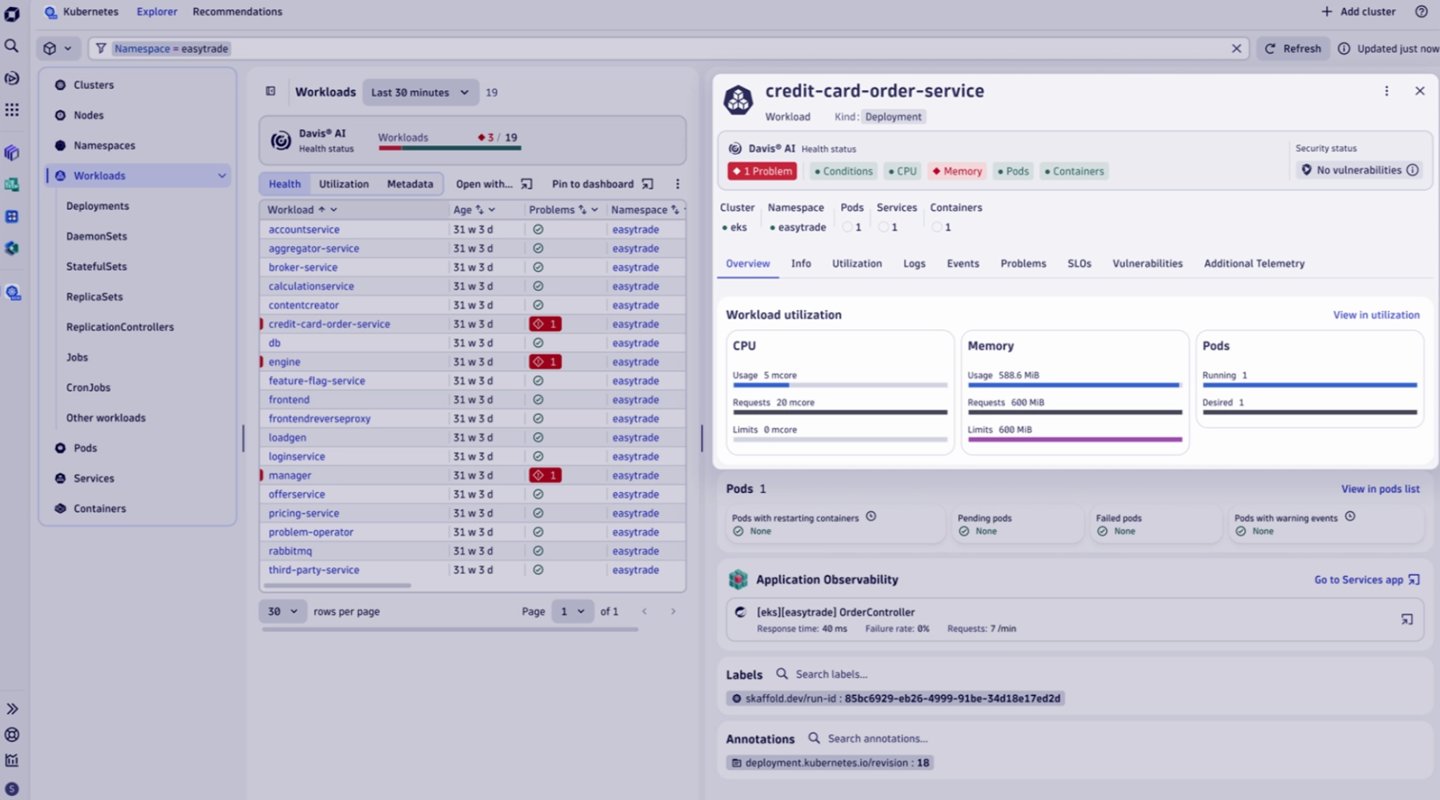TechRadar Verdict
Dynatrace is a comprehensive observability platform that goes beyond traditional network monitoring to provide AI-driven insights and visibility. While its premium pricing and complexity may deter smaller organizations, enterprise teams will find its advanced capabilities justify the investment.
Pros
- +
AI-driven root cause analysis
- +
Full-stack monitoring coverage
- +
Process-level network visibility
Cons
- -
Complex pricing structure
- -
Steep learning curve
- -
Expensive for smaller organizations
Why you can trust TechRadar
Dynatrace positions itself as a leader in the competitive network monitoring space, offering a complete observability platform that extends far beyond basic network metrics. While on the hunt for the best network monitoring tools of 2025, we found it to be particularly strong for enterprise environments with complex and distributed infrastructures.
TechRadar reviewers spend several weeks researching each major IT platform in the market, analyzing everything from core functionality to pricing and customer support quality. When we looked at Dynatrace, we were especially impressed by its AI-powered Davis engine, which automatically detects anomalies and performs root cause analysis across your entire stack.
While our top pick LogicMonitor remains the best overall network monitoring tool of 2025, Dynatrace offers unique strengths for organizations needing comprehensive observability beyond traditional network monitoring. Dynatrace has also been recognized as a leader in G2's Network Monitoring for 2025 and Gartner's Magic Quadrant for Observability Platforms.
Dynatrace: Features
Dynatrace is an exceptionally feature-rich platform that goes well beyond traditional network monitoring to provide observability across applications, infrastructure, and user experience. It's primarily geared toward enterprise organizations with complex environments distributed across multiple cloud and on-premises systems.
Features are generally well-executed, with particular strengths in automated discovery, dependency mapping, and intelligent alerting, though some users note that pure network monitoring capabilities aren't as robust as specialized tools like SolarWinds NPM. While the premium pricing makes it inaccessible for small teams, the feature set justifies the cost for organizations looking for unified observability over point solutions.
Full-stack monitoring
Dynatrace's flagship capability provides end-to-end visibility from user experience down to infrastructure components, automatically discovering and mapping all dependencies across your technology stack. The OneAgent technology deploys with minimal configuration and begins collecting metrics, traces, and logs immediately, supporting automatic instrumentation for hundreds of technologies without manual intervention. This eliminates the blind spots common in traditional monitoring approaches by correlating performance issues across all tiers of your environment.
Sign up to the TechRadar Pro newsletter to get all the top news, opinion, features and guidance your business needs to succeed!
AI-powered analytics
The Davis AI engine serves as Dynatrace's differentiating factor, continuously analyzing billions of dependencies and metrics to automatically detect anomalies and determine root causes. Rather than simply alerting on threshold breaches, Davis provides context-aware insights that help IT teams understand not just what happened, but why it happened and what should be done about it. It reduces alert noise significantly while ensuring critical issues receive immediate attention with actionable remediation guidance.
Network performance monitoring
While network monitoring isn't Dynatrace's primary strength, the platform provides process-level network visibility that goes beyond traditional host-based monitoring. You can track network performance metrics between specific processes and services, identify connection issues proactively, and understand network topology in dynamic cloud environments. The platform automatically monitors new network interfaces and provides integrated health metrics alongside other key resource indicators.
Real user monitoring
Dynatrace captures actual user interactions across web, mobile, and API channels to provide insights into real-world performance and user experience. It tracks click patterns, page load times, and user journeys while identifying frustration points and performance bottlenecks that impact customer satisfaction. This extends beyond synthetic testing to understand how actual users experience your applications under real-world conditions.

Dynatrace: Ease of Use
Dynatrace comes with a modern interface that uses its Smartscape data visualization to help users understand complex environment relationships at a glance. Its automatic discovery capabilities significantly reduce initial setup complexity, with deployment typically completing in minutes without extensive configuration.
However, the sheer breadth of features and data available can create a steep learning curve for new users, particularly those transitioning from simpler monitoring tools. That said, the platform includes helpful features like in-product live chat assistance available directly within the interface, allowing users to get immediate help without leaving their monitoring environment.
Dynatrace has invested heavily in user experience improvements, with recent updates focusing on streamlining workflows and reducing the number of clicks required for common tasks. While the learning curve exists, IT teams find the investment in training worthwhile given the platform's capabilities and the reduction in time-to-resolution it provides for complex issues.
Dynatrace: Pricing
Plan | Starting price (paid annually) | What's included |
|---|---|---|
Infrastructure Monitoring | $0.04 per hour per host | Host monitoring for any server size, with basic dashboards and alerting |
Kubernetes Platform Monitoring | $0.002 per hour | Complete observability across all Kubernetes clusters, workloads, pods and more |
Synthetic Monitoring | $0.001 per request | High throughput monitoring for browser clickpaths, single pages, and APIs |
Full-Stack Monitoring | $0.08 per hour per host | Complete APM and observability, AI-powered insights, OneAgent deployment, OpenTelemetry support |
Dynatrace employs a usage-based pricing model that scales with your environment size and monitoring requirements. There's no hidden fees, but you'll be making potentially complex cost calculations for larger deployments.
It works well for organizations with predictable infrastructure sizes, plus volume discounts make it more attractive for enterprise deployments. Compared to competitors, Dynatrace sits at the premium end of the market, which reflects its comprehensive feature set but may price out smaller organizations that need simpler network monitoring solutions.
Dynatrace: Customer Support
Dynatrace offers two tiers of support: Standard Support included with all subscriptions and Enterprise Support for customers requiring enhanced service levels.
Standard Support includes in-product live chat assistance available directly within the Dynatrace interface, allowing users to connect with product experts for configuration questions and basic troubleshooting during business hours. The support team has access to product development experts for complex issues, ensuring customers can reach the right level of expertise when needed.
Enterprise Support provides enhanced response times, dedicated support resources, and expanded coverage hours for mission-critical environments. All customers also have access to comprehensive self-help resources including detailed documentation, the Dynatrace Community forum, and Dynatrace University for training and certification.
While support quality generally receives positive feedback from enterprise customers, some smaller organizations report challenges getting rapid responses during peak periods with Standard Support.
Dynatrace: Alternatives
Dynatrace occupies a unique position in the observability market, serving as both a comprehensive monitoring platform and a specialized network monitoring tool, though its strength lies more in the former. It's best suited for enterprises with distributed environments where the AI-driven insights and visibility justify the premium pricing and complexity.
If you're looking for pure network monitoring tools, you might find better value in specialized tools like SolarWinds Network Performance Monitor or PRTG. But for organizations looking for network monitoring and observability, Dynatrace's main competitors include New Relic and Datadog.
Dynatrace: Final Verdict
Dynatrace delivers exceptional value for enterprise organizations requiring comprehensive observability beyond traditional network monitoring, with its AI-powered Davis engine and full-stack visibility providing capabilities that few competitors can match. It excels in complex, distributed environments where automatic discovery, dependency mapping, and intelligent root cause analysis justify the premium pricing and learning curve investment.
While pure network monitoring isn't Dynatrace's strongest suit compared to specialized tools, its ability to correlate network issues with application and infrastructure performance makes it valuable for organizations seeking unified observability. However, smaller organizations or those with simpler network monitoring needs may find Dynatrace overkill in both complexity and cost, making alternatives like LogicMonitor or PRTG more practical choices.
Dynatrace: FAQs
Is Dynatrace primarily a network monitoring tool?
No, Dynatrace is primarily an observability platform that includes network monitoring as one component of its full-stack approach. While it provides process-level network visibility and can monitor network performance between services, its core strength lies in application performance monitoring, infrastructure monitoring, and AI-driven analytics across the entire technology stack. Those looking for dedicated network monitoring tools might find better value in specialized solutions like LogicMonitor or SolarWinds NPM.
How does Dynatrace pricing work for growing organizations?
Dynatrace uses a usage-based pricing model where costs scale with your monitored infrastructure, measured in host-hours or GiB-hours depending on the plan. The platform offers volume discounts for larger commitments and allows organizations to exceed their minimum annual commitment on an on-demand basis without penalties. While this flexibility helps growing organizations, costs can increase significantly as infrastructure scales, making budget planning important for expansion.
What level of expertise is required to implement Dynatrace?
Dynatrace is designed for enterprise IT teams and requires moderate to advanced expertise to fully leverage its capabilities, though initial deployment is relatively straightforward thanks to OneAgent's automatic discovery.
While the platform can begin collecting data within minutes of deployment, maximizing its AI-driven insights, custom dashboards, and advanced alerting typically requires several weeks of learning and configuration.
Dynatrace provides comprehensive training resources through Dynatrace University and offers in-product support to help teams get up to speed.
Can Dynatrace replace multiple monitoring tools?
Yes, Dynatrace is specifically designed to consolidate multiple monitoring functions into a single platform, covering application performance, infrastructure monitoring, network monitoring, real user monitoring, and synthetic testing.
This eliminates data silos and provides correlated insights across the entire technology stack, which is particularly valuable for complex enterprise environments. However, organizations with specialized needs might still require dedicated tools for specific use cases like detailed network flow analysis or specialized database monitoring.
How does Dynatrace compare to other observability platforms?
Dynatrace differentiates itself primarily through its Davis AI engine, which provides automated root cause analysis and intelligent alerting beyond what competitors like New Relic or Datadog typically offer.
It also excels in automatic discovery and dependency mapping, requiring less manual configuration than many alternatives. However, it comes with premium pricing that may exceed competitors, and some users find its comprehensive feature set more complex than needed for simpler monitoring requirements.
Check out the best IT asset management software.

Ritoban Mukherjee is a tech and innovations journalist from West Bengal, India. These days, most of his work revolves around B2B software, such as AI website builders, VoIP platforms, and CRMs, among other things. He has also been published on Tom's Guide, Creative Bloq, IT Pro, Gizmodo, Quartz, and Mental Floss.
You must confirm your public display name before commenting
Please logout and then login again, you will then be prompted to enter your display name.
